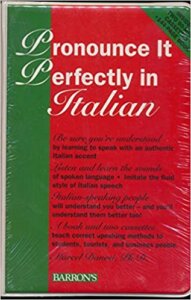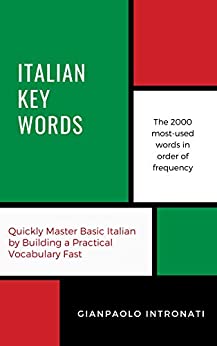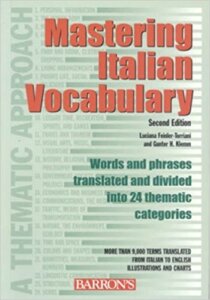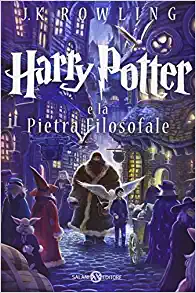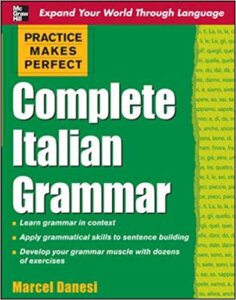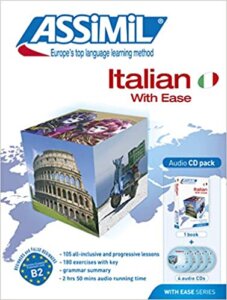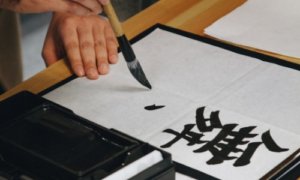If you’re after the best way to learn Italian, you’re going to need to learn correct pronunciation, a frequency dictionary to form your base vocabulary, and a good grammar book. You’ll also benefit from a thematic vocabulary book for specialized vocabulary, and maybe a book or two, once you learn your first 1,000 words.
Learn Italian with these resources
Italian language resources, for some reason, are missing a few parts: there are a lot of books that are very hard to get in the USA, and things like frequency dictionaries simply don’t seem to exist. Make sure you read our Method articles for top advice and tips, then check out some of these recommended resources (pictures are links):
1. Pronunciation
Note: As a faster (and more effective) alternative to the following pronunciation resources, check out my Kickstarter project. It will make the first steps of Italian much easier for you because it takes advantage of how your brain works (and how to re-wire it) in a way that traditional tools just can’t.
First off, get a feel for how pronunciation works in English. The video tutorials here should help. Once you understand that, start working on Italian.
The Pronounce It Perfectly series comes with recordings and all the pronunciation rules, and I’ve yet to see one that wasn’t excellent. The reviews on the Italian version are generally good, and it’s certainly the only book of its kind that seems to be of any use (The Say It Right series uses primavera: pree – mah – VE – rah. Aghh). The problem with this Pronounce It Perfectly edition is that it comes with cassettes, of all things!
If you want to jump to free internet resources, check out Wikipedia’s Italian Phonology page. You can also use the DOP (pronunciation dictionary), released for free with recordings on the net.
There are also some Anki flashcards for Italian to improve your pronunciation, such as the Italian alphabet, Italian IPA Pronunciation, Italian minimal pairs, and other useful goodies.
At a bare minimum, your goal is to be able to easily hear and say the difference between double consonants and single consonants (caro vs carro and sete vs sette, for example), the difference between the alveolar /n/ nasal consonant (in cane) and the palatal /ɲ/ consonant (in bagno), and the difference between the palatal and alveolar lateral consonants (aglio vs allo, for example). Once you get those, you’re pretty much ready. If you want a really perfect accent, you’ll then need to focus on getting the pure vowels just right (no American Os), and learning to make an unaspirated /t/, /p/, and /k/. (And if you’re a perfectionist, learn which words voice their double Zs and which unvoice them, as well as which words use closed and open Es and Os.)
2. Your base vocabulary
I’ve made a base vocabulary list of 625 words to start you off! As I talk about in that article, I find it easiest to translate those words using the short dictionaries at the end of a Lonely Planet phrasebook: they’re cheap, short, and they give you good, standard translations for your words (just ignore the ridiculous pronunciation guides). Later, when you’re ready for sentences, you can go back to your phrasebook and grab some. After that, try some of these resources:
Italian Key Words is one of the only frequency lists that exist for Italian. There are a couple of online options (a 1,000-word list here and a fairly academic list of 3,100 words here), but I find that the lack of translations makes them both fairly hard to use. I’d suggest the book.
You can also access Anki decks to boost up your Italian vocabulary, like the Italian alphabet, Italian Top 2000 Words, and many more.
Il Primissimo Zanichelli dell’accoglienza is an incredible book. It describes ~1,200 words exclusively with pictures and examples that you should be able to understand on your first day. You can find example pages here. It’s hard to get; I’ve linked to Amazon, but unless someone is selling it used or you’re buying in Europe, it’s pretty expensive. Alternatively, you can try Book Depository, which usually will find you some better prices.
Vocabulary book
The Mastering Vocabulary series is a wonderful set of books that contain core vocab for just about any field/topic you can think of. You can certainly make do with just this book if you can’t get the Primissimo Zanichelli.
The only online Italian frequency list I’ve found is this one, which is a bit messy but gets the job done. If someone happens to find a better one, let me know and I’ll put it up here!
On the internet, you can also find a neat set of sentences that are ranked based upon how frequently the words within those sentences show up within the language, then create Anki decks to store them, with text-to-speech recordings of each sentence and translations. They’re a nice resource to mine for useful content. I’d suggest finishing the 625, then looking through them in order for new words or new grammatical constructions, and then learning those new chunks via New Word cards, New Word Form cards, and Word Order cards.
3. Grammar book
I’m a big fan of the Un Tuffo/Volo nell’Azzurro series, but they’re hard to find in the US (they’re also 100% in Italian, which is not everyone’s cup of tea). You can often find affordable copies on Book Depository (or try Amazon if you’re not in the US). In terms of something a bit easier to get a hold of, the Practice Makes Perfect series is well-reviewed and covers the whole body of Italian grammar at a sufficiently high level. The only problem with this book seems to be with vocabulary, which you’re dealing with already in Step 2.
4. Book-type book
You can read anything that you enjoy. I’m a big fan of the Harry Potter series in translation, especially if you can find an audiobook version to listen to at the same time as reading.
5. Other resources
Anki decks
I’m making my personal Anki deck available here. Please read the notes!
If you have more questions about Anki and learning Italian, there’s also the Anki language learners’ community on Reddit. You can even check out this Anki language learning blog for other Anki tips and tricks for learning Italian.
Monolingual dictionaries
You’ll want to move to a monolingual dictionary as soon as possible. I’ve been a big fan of Hoepli’s online dictionary. Hoepli’s tends to be easy to understand. You might need to make an account, but then it’s free.
Assimil
The Assimil series is a sort of special language-learning resource that I discuss in a blog post here. It doesn’t quite fit into any of the categories above, and I think it works best as a sort of supplemental source of Italian input. Here’s the beginner Italian version with CDs.
Dictionarist
Dictionarist provides translations, example sentences, conjugations, and synonyms for a number of languages including Italian.
6. Try the Fluent Forever app
By the way, did you know the book is now an app? You can check out the Fluent Forever app right here to boost your Italian language learning progress.Discover our immersive method rooted in neuroscience, designed to take you to fluency in < 30 minutes a day through four steps:
- Train your ears with pronunciation lessons
- Learn vocabulary through images instead of translations
- Learn grammar naturally through stories relevant to you
- Practice your speech to fluency with native tutors
Ready to start your journey to Italian fluency? Download our Fluent Forever app right now!


